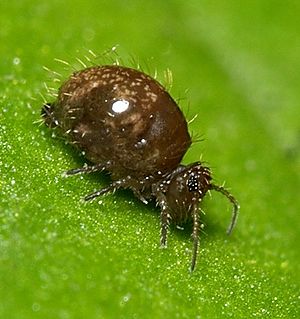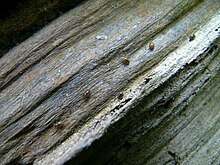Dark brown ball diver
| Dark brown ball diver | ||||||||||||
|---|---|---|---|---|---|---|---|---|---|---|---|---|

Dark brown ball diver |
||||||||||||
| Systematics | ||||||||||||
|
||||||||||||
| Scientific name | ||||||||||||
| Allacma fusca | ||||||||||||
| ( Linnaeus , 1758) |
The dark brown puffer , scientific name Allacma fusca , is a species of springtails or collembola. It lives in the litter layer of damp forests and on dead wood . The species was declared Insect of the Year in Germany, Austria and Switzerland in 2016 .
description
With a body length of up to four millimeters, the dark brown puffer is a small arthropod, but it is already unusually large for a springtail: it is the largest species of European puffer. The body is dark brown in color and shiny, the head a little lighter, occasionally brown spotted animals appear. It is recognizable as a ball spinger by its rounded body shape with an indistinctly segmented body, the abdominal segments one to four are fused together. It can be distinguished from other types of puffer (Symphypleona) by its unusual body size, its color and the shape of the antennae : the fourth antenna segment is no shorter than the third, the antennae are also "kneeled" by being between segment three and four (which is divided into about 15 ringlets or subsegments) form a clear angle. The head has large, easily recognizable eyes of black color, which consist of eight ommatidia . The species is one of the few springtail species that can be seen under magnifying glass.
It can possibly be confused with its sister species Allacma gallica , which is only widespread in southern and western Europe; there are only a few findings from Germany that are probably based on introduction. The species can only be distinguished by specialists under the microscope, on the basis of the bristling (chaetotaxia) of the ankle and the shape of a gland opening on the abdomen. Special features of the genus Allacma are: The trochanter of the last pair of legs has a flattened thorn on the inside, and in front of each of the two ommen fields there is a characteristically shaped post antennal bristle.
Life cycle
The species goes through four developmental stages up to the sexually mature adult stage, between each of which a molt, with increasing size, is switched on. It overwinters in the ice stage. Young animals hatch from the end of April, the last adults can be observed until the end of October. When mating, the male releases a spermatophore , which the female takes up from the substrate surface alone or with the assistance of the male. While the first stages of youth are very humid, the later stages are quite resistant to dehydration. However, their resistance to dehydration is lower than that of other ball divers such as Sminthurus viridis .
Habitat and way of life
The dark brown spherical diver lives in moist forests, where it can be seen in the litter layer and on dead wood, for example on fallen branches and tree stumps; seldom it is found in bogs, caves, in grassland, in dune areas and in nests of small mammals. The species migrates from the surface of the soil to wood, on which it grazes the algae, especially in damp weather. The animals are gregarious (ferocious) and sometimes to be found in larger groups, their surface is shiny due to a wetting water film.
Area and distribution
Allacma fusca is widespread in the Holarctic . There is evidence from almost all of Europe, the Mediterranean and Black Sea regions, Siberia, Canada and Greenland.
Phylogeny and Taxonomy
The species was first described by Carl von Linné as Podura fusca . It is a type of the genus Allacma , Börner, 1906.
The genus Allacma includes, depending on the opinion, up to seven species, of which only three are found more frequently: in addition to the European species Allacma fusca and Allacma gallica, the East Asian species Allacma koreana . According to genetic data, Allacma fusca and Allacma gallica are reproductively isolated from each other , even where they occur together (sympatric), that is, hybrids do not form . In spite of sexual reproduction, Allacma fusca is genetically relatively uniform with little variability. This is attributed to a peculiarity of sperm formation in males: In meiosis , there is no crossing-over .
Insect of the year 2016
The dark brown spherical diver was voted Insect of the Year 2016. This choice was an example of the numerous, often tiny, species of soil fauna that are of great importance for the functionality of our soils by breaking down organic substances and making them available again as nutrients for plants. In addition, the organisms of the soil fauna direct the microbial activity and thus accelerate the metabolism.
Individual evidence
- ↑ Hans-Jürgen Schulz: Collembola - Springtails. In: Bernhard Klausnitzer (Hrsg.): Stresemann - excursion fauna of Germany. Volume 2: Invertebrates: Insects. Springer-Verlag, 2011, ISBN 978-3-8274-2452-5 .
- ↑ a b Pierre Nayrolles: A standardized description of European Sminthuridae (Collembola, Symphypleona), 2: review of four species of the genera Allacma and Spatulosminthurus. In: Bijdragen tot de Dierkunde. 64, No. 3, 1994, pp. 151-162. ( repository.naturalis.nl )
- ^ Gerhard Bretfeld: Synopses on Palaearctic Collembola part 2: Symphypleona. In: Treatises and reports of the Natural History Museum Görlitz 71, No. 1, pp. 1–318.
- ↑ a b Arne Fjellberg: The Collembola of Fennoscandia and Denmark. Part II: Entomobryomorpha and Symphypleona (= Fauna Entomologica Scandinavica. 42). Brill Scientific Publishers, Leiden 2007, ISBN 978-90-04-15770-5 . Allacma fusca. Pp. 222-223.
- ↑ a b U. Burkhardt, HJ Schulz, A. Stark: Things worth knowing about the ball diver (Collembola, Symphypleona) on the occasion of the election of Allacma fusca (Linnaeus, 1758) to the insect of the year 2016. In: Entomologische Nachrichten undberichte. 60, 2016, pp. 9-14.
- ^ A b Pietro P. Fanciulli, Antonio Carapelli, Massimo Belloni, Romano Dallai, Francesco Frati: Allozyme variation in the springtails Allacma fusca and A. gallica (Collembola, Sminthuridae) . In: Pedobiologia . tape 52 , no. 5 , July 25, 2009, p. 309-324 , doi : 10.1016 / j.pedobi.2008.11.004 .
- ↑ a b Checklist of the Collembola: Sminthurinae on collembola.org by Frans Janssens. As of August 8th.
- ↑ Information leaflet on Insect of the Year 2016: The Dark Brown Ball Diver (PDF)
Web links
- NABU - the dark brown puffer is Insect of the Year 2016
- Checklist of the Collembola: Sminthurinae on collembola.org by Frans Janssens. Last updated on 07.03.2016. Website with numerous photos of the species.
